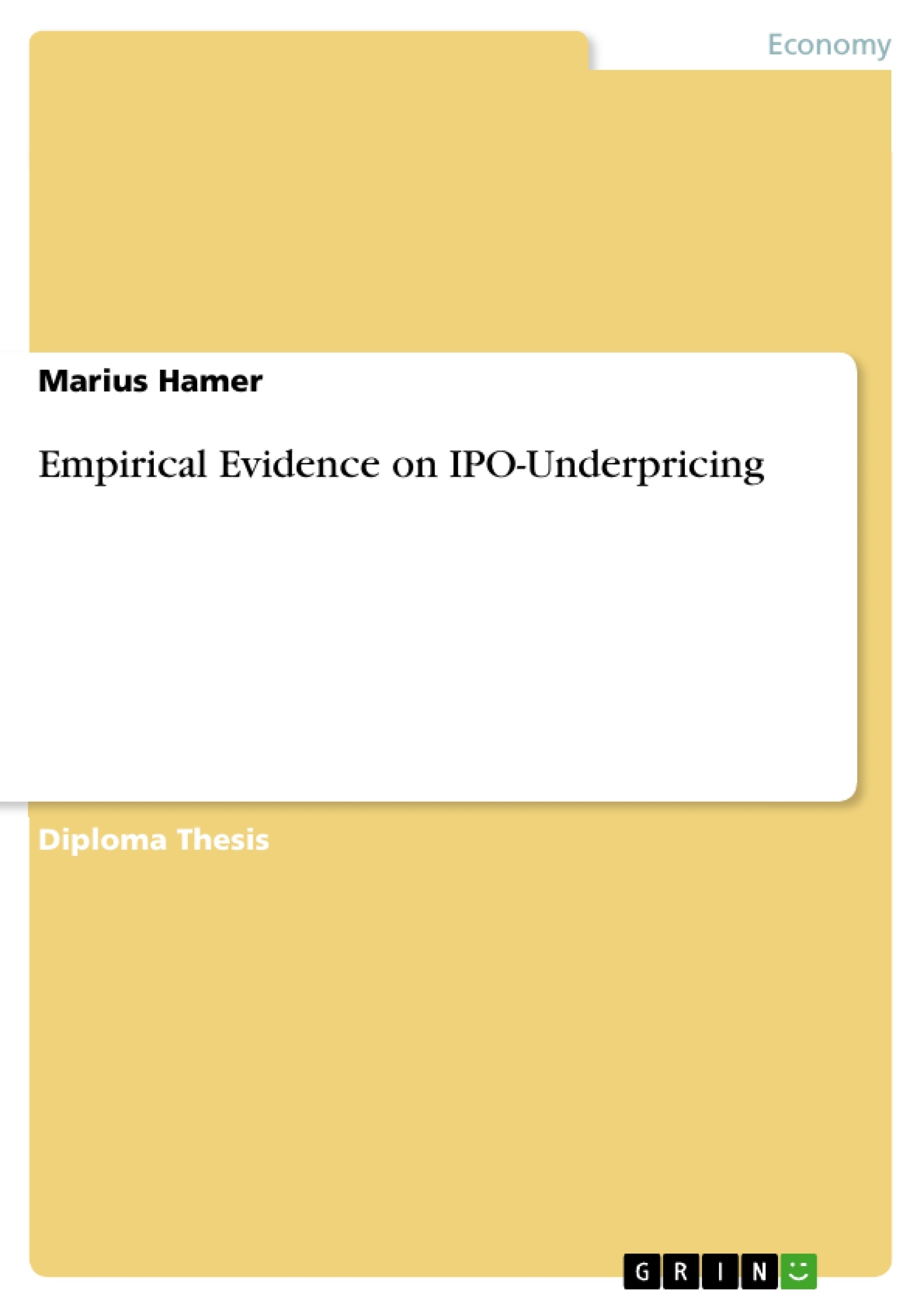This paper aims at establishing a link between the average level of initial return of IPO shares, existing underpricing explanations and the dot-com bubble. In years prior to the boom of the new economy, underpricing was explained by various theories, which have extensively been developed since decades. However, in the years 1998 to 2001 IPOs were overly underpriced, leading to assumptions about behavioural aspects and investor irrationality. Analysing a comprehensive dataset of 371 IPOs on the Frankfurter Börse between 1997 and 2007, this paper aims at providing evidence that the observed lower levels of initial returns in recent years can indeed be aligned with existing theories on the basis of rational behaviour of market participants.
Firstly, the IPO process and its major participants will be presented followed by a review of relevant studies on the IPO phenomenon. In the next step, established underpricing theories are recapitulated. A descriptive analysis of the data sample points out the particularities concerning the company and transaction characteristics of the sample firms. In a last step, a regression analysis relates various proxies for information asymmetry to established underpricing theories. It gives reason to believe that the irrationality at the turn of the century has vanished and that underpricing can again be explained by established theories.
Inhaltsverzeichnis (Table of Contents)
- 1 INTRODUCTION
- 2 INITIAL PUBLIC OFFERINGS.
- 2.1 The IPO Process.
- 2.1.1 Institutions and Roles in IPOs.
- 2.1.2 IPO Transactions.
- 2.1.3 International Equity Issuing Conditions..
- 2.2 Empirical Evidence on IPO-Underpricing
- 2.2.1 Definition of IPO-Underpricing.
- 2.2.2 Evidence on Underpricing and Country Differences.
- 2.2.3 Long-Term IPO Performance Studies.
- 3 THEORIES EXPLAINING IPO-UNDERPRICING.
- 3.1 Institutional Explanations...
- 3.1.1 Reduction of Legal Liability.
- 3.1.2 Analyst Compensation Theory.
- 3.1.3 Banking Relationships…...
- 3.2 Models based on Ownership and Control
- 3.2.1 Reduced Monitoring Theory.
- 3.2.2 Increased Monitoring Theory.
- 3.3 Models based on Information Asymmetry..
- 3.3.1 Information Asymmetry between Issuer and Investor.
- 3.3.2 Information Asymmetry between Investor Groups........
- 3.3.3 Information Asymmetry between Underwriter and Investor.
- 3.4 Theories related to Individual Rent-Seeking Behaviour
- 3.4.1 Underpricing to the Benefit of the Management.
- 3.4.2 Underpricing to the Benefit of the Underwriter
- 4 THE MODEL.
- 4.1 Sample Description
- 4.1.1 Investigation of Data
- 4.1.2 Descriptive Characteristics of Sample Firms ..
- 4.2 The Regression Model...\n
- 4.3 Results of the Regression Analysis.
- 4.4 Interpretation of Regression Results
- 4.5 Alternative Interpretation.
- 5 CONCLUSION.
Zielsetzung und Themenschwerpunkte (Objectives and Key Themes)
This paper aims to investigate the phenomenon of IPO-underpricing in the German market. The author seeks to connect established theoretical models with empirical analysis, aiming to better understand the motivations behind underpricing in Germany. The research involves a thorough literature review of different approaches to explaining underpricing and the development of a regression model based on a comprehensive dataset of German IPOs. The paper focuses on testing theoretical models based on information asymmetry and offers an alternative explanation based on behavioral patterns observed in the early 2000s.
- IPO-underpricing and its significance in the German market.
- Theories explaining IPO-underpricing, including institutional explanations, models based on ownership and control, models based on information asymmetry, and theories related to individual rent-seeking behavior.
- Empirical analysis of IPOs in Germany using a regression model.
- Testing theoretical models based on information asymmetry.
- Alternative interpretation of underpricing based on behavioral patterns.
Zusammenfassung der Kapitel (Chapter Summaries)
The introduction establishes the significance of the IPO process for companies and discusses the phenomenon of IPO-underpricing, highlighting its prevalence and the academic debate surrounding it. Chapter 2 provides a comprehensive overview of initial public offerings, delving into the IPO process, relevant institutions and roles, IPO transactions, and international equity issuing conditions. The chapter also reviews empirical evidence on IPO-underpricing, including its definition, evidence on underpricing and country differences, and long-term IPO performance studies. Chapter 3 explores various theories explaining IPO-underpricing, encompassing institutional explanations, models based on ownership and control, models based on information asymmetry, and theories related to individual rent-seeking behavior.
Chapter 4 outlines the model used in the empirical analysis, including sample description, investigation of data, descriptive characteristics of sample firms, the regression model itself, results of the regression analysis, interpretation of regression results, and an alternative interpretation.
Schlüsselwörter (Keywords)
The main keywords and focus topics of the paper are IPO-underpricing, initial public offerings, information asymmetry, German IPO market, empirical analysis, regression model, institutional explanations, ownership and control, individual rent-seeking behavior, and behavioral patterns.
- Quote paper
- Diplom-Kaufmann Marius Hamer (Author), 2007, Empirical Evidence on IPO-Underpricing, Munich, GRIN Verlag, https://www.grin.com/document/76172



